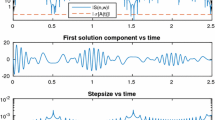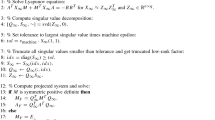Abstract
We consider Lyapunov exponents and Sacker–Sell spectrum for linear, nonautonomous retarded functional differential equations posed on an appropriate Hilbert space. A numerical method is proposed to approximate such quantities, based on the reduction to finite dimension of the evolution family associated to the system, to which a classic discrete QR method is then applied. The discretization of the evolution family is accomplished by a combination of collocation and generalized Fourier projection. A rigorous error analysis is developed to bound the difference between the computed stability spectra and the exact stability spectra. The efficacy of the results is illustrated with some numerical examples.






Similar content being viewed by others
References
Badawy, M., Van Vleck, E.: Perturbation theory for the approximation of stability spectra by QR methods for sequencies of linear operators on a Hilbert space. Linear Algebra Appl. 437(1), 37–59 (2012)
Bellen, A., Zennaro, M.: Numerical methods for delay differential equations. Numerical Mathemathics and Scientifing Computing series. Oxford University Press, Oxford (2003)
Benettin, G., Galgani, L., Giorgilli, A., Strelcyn, J.M.: Lyapunov exponents for smooth dynamical systems and for hamiltonian systems; a method for computing all of them. Part 1: theory. Meccanica 15, 9–20 (1980)
Benettin, G., Galgani, L., Giorgilli, A., Strelcyn, J.M.: Lyapunov exponents for smooth dynamical systems and for hamiltonian systems; a method for computing all of them. Part 2: numerical applications. Meccanica 15, 21–30 (1980)
Bensoussan, A., Da Prato, G., Delfour, M.C., Mitter, S.K.: Representation and control of infinite dimensional systems, vol. I and II. Birkhäuser, Boston (1992, 1993)
Benzoni-Gavage, S.: Stability of semi-discrete shock profiles by means of an Evans function in infinite dimensions. J. Dyn. Differ. Equ. 14(3), 613–674 (2002)
Benzoni-Gavage, S., Huot, P.: Existence of semi-discrete shocks. Discret. Contin. Dyn. S. 8, 163–190 (2002)
Bernier, C., Manitius, A.: On semigroups in \(\mathbb{R}^{n}\times L^{p}\) corresponding to differential equations with delays. Can. J. Math. 30(5), 897–914 (1978)
Borisovic̆, J.G., Turbabin, A.S.: On the Cauchy problem for linear nonhomogeneous differential equations with retarded arguments. Dokl. Akad. Nauk SSSR 185(4), 741–744 (1969). English transl. Soviet Math. Dokl. 10(2):401–405 (1969)
Breda, D.: Nonautonomous delay differential equations in Hilbert spaces and Lyapunov exponents. Diff. Int. Equ. 23(9–10), 935–956 (2010)
Breda, D., Maset, S., Vermiglio, R.: Pseudospectral differencing methods for characteristic roots of delay differential equations. SIAM J. Sci. Comput. 27(2), 482–495 (2005)
Breda, D., Maset, S., Vermiglio, R.: Pseudospectral techniques for stability computation of linear time delay systems. In: 44th IEEE Conference on Decision and Control and European Control Conference (CDC/ECC 2005) (2005)
Breda, D., Maset, S., Vermiglio, R.: On discretizing the semigroup of solution operators for linear time invariant—time delay systems. In: Vyhlidal, T., Zitek, P. (eds.) Time Delay Systems 2010, IFAC Proceedings Volumes, vol. 9. Elsevier, Oxford (2010)
Breda, D., Maset, S., Vermiglio, R.: Approximation of eigenvalues of evolution operators for linear retarded functional differential equations. SIAM J. Numer. Anal. 50(3), 1456–1483 (2012)
Canuto, C., Hussaini, M.Y., Quarteroni, A., Zang, T.: Spectral Methods. Evolution to Complex Geometries and Applications to Fluid Dynamics. Scientific Computation Series. Springer, Berlin (2007)
Chicone, C., Latushkin, Y.: Evolution semigroups in dynamical systems and differential equations. No. 70 in SURV series. American Mathematical Society, USA (1999)
Chow, S.N., Leiva, H.: Existence and roughness of the exponential dichotomy for skew-product semiflow in Banach spaces. J. Differ. Equ. 120(2), 429–477 (1995)
Chow, S.N., Leiva, H.: Two definitions of exponential dichotomy for skew-product semiflow in Banach spaces. Proc. Am. Math. Soc. 124, 1071–1081 (1996)
Chow, S.N., Leiva, H.: Unbounded perturbation of the exponential dichotomy for evolution equations. J. Differ. Equ. 129, 509–531 (1996)
Colonius, F., Manitius, A., Salamon, D.: Structure and duality for time varying linear retarded equations. J. Differ. Equ. 78, 320–353 (1989)
Delfour, M.C.: State theory of linear hereditary differential systems. J. Differ. Equ. 60, 8–35 (1977)
Delfour, M.C.: The largest class of hereditary systems defining a \(C_{0}\)-semigroup on the product space. Can. J. Math. 32, 466–490 (1980)
Delfour, M.C., Mitter, S.K.: Hereditary differential systems with constant delays. I. General case. J. Differ. Equ. 12, 213–235 (1972)
Delfour, M.C., Mitter, S.K.: Hereditary differential systems with constant delays. II. A class of affine systems and the adjoint problem. J. Differ. Equ. 18, 18–28 (1975)
Di Blasio, G.: Nonautonomous functional differential equations in Hilbert spaces. Nonlinear Anal. T.M.A. 9(12), 1367–1380 (1985)
Dieci, L., Elia, C.: The singular value decomposition to approximate spectra of dynamical systems. J. Differ. Equ. 230(2), 502–531 (2006)
Dieci, L., Van Vleck, E.S.: Lyapunov and other spectra: a survey. In: Estep, D.J., Taverner, S. (eds.) Collected lectures on the preservation of stability under discretization, pp. 197–218. SIAM, Philadelphia (2002)
Dieci, L., Van Vleck, E.S.: Lyapunov spectral intervals: theory and computation. SIAM J. Numer. Anal. 40(2), 516–542 (2002)
Dieci, L., Van Vleck, E.S.: On the error in computing Lyapunov exponents by QR methods. Numer. Math. 101, 398–423 (2005)
Dieci, L., Van Vleck, E.S.: Perturbation theory for approximation of Lyapunov exponents by QR methods. J. Dyn. Differ. Equ. 15, 815–840 (2006)
Dieci, L., Van Vleck, E.S.: Lyapunov and Sacker–Sell spectral intervals. J. Dyn. Differ. Equ. 19, 263–295 (2007)
Dieci, L., Van Vleck, E.S.: On the error in QR integration. SIAM J. Numer. Anal. 46, 1166–1189 (2008)
Diekmann, O., van Gils, S.A., Verduyn Lunel, S.M., Walther, H.O.: Delay Equations—Functional, Complex and Nonlinear Analysis. No. 110 in AMS series. Springer, New York (1995)
Eden, A., Foias, C., Temam, R.: Local and global Lyapunov exponents. J. Dyn. Differ. Equ. 3(1), 133–177 (1991)
Farmer, D.: Chaotic attractors of an infinite-dimensional dynamical system. Phys. D 4, 605–617 (1982)
Fattouh, A., Sename, O., Dion, J.M.: \(h_{\infty }\) controller and observer design for linear systems with point and distributed delays. In: 2nd IFAC workshop on Linear Time Delay Systems, Ancona, Italy (2000)
Hadd, S., Rhandi, A., Schnaubelt, R.: Feedback theory for time-varying regular linear systems with input and state delays. IMA J. Math. Control Inf. 25(1), 85–110 (2008)
Hale, J.K., Verduyn Lunel, S.M.: Introduction to functional differential equations, 2nd edn. No. 99 in AMS series. Springer, New York (1993)
Ichikawa, A.: Quadratic control of evolution equations with delays in control. SIAM J. Control Optim. 20, 645–668 (1982)
Insperger, T., Stépán, G.: Updated semi-discretization method for periodic delay-differential equations with discrete delay. Int. J. Numer. Methods Eng. 61, 117–141 (2004)
Ito, K., Kappel, F.: A uniformly differentiable approximation scheme for delay systems using splines. Appl. Math. Opt. 23, 217–262 (1991)
Kappel, F.: Semigroups and delay equations. No. 152 (Trieste, 1984) in Pitman Res. Notes Math. Ser. Longman Sci. Tech., Harlow (1986)
Krasovskii, N.: Stability of motion. Moscow (1959). English transl. Stanford University Press (1963)
Mackey, M.C., Glass, L.: Oscillations and chaos in physiological control systems. Science 197, 287–289 (1977)
Menosur, B., Lotgin, A.: Power spectra and dynamical invariants for delay-differential and difference equations. Phys. D 113, 1–25 (1998)
Menosur, B., Lotgin, A.: Synchronization of delay-differential equations with applications to private communication. Phys. Lett. A 244, 59–70 (1998)
Oseledets, V.I.: A multiplicative ergodic theorem. Lyapunov characteristic numbers for dynamical systems. English Transl. Trans. Mosc. Math. Soc. 19, 197–221 (1968)
Peichl, G.H.: A kind of “history space” for retarded functional differential equations and representation of solutions. Funkc. Ekvacioj-SER I 25, 245–256 (1982)
Pliss, V.A., Sell, G.R.: Robustness of exponential dichotomies in infinite-dimensional dynamical systems. J. Dyn. Differ. Equ. 11(3), 471–513 (1999)
Prasad, A.: Amplitude death in coupled chaotic oscillators. Phys. Rev. E 72(056), 204–10 (2005)
Ruelle, D.: Characteristic exponents and invariant manifolds in Hilbert space. Ann. Math. 115, 243–290 (1982)
Sacker, R.J., Sell, G.R.: Dichotomies for linear evolutionary equations in Banach spaces. J. Differ. Equ. 113, 17–67 (1994)
Sell, G.R., You, Y.: Dynamics of evolutionary equations. No. 143 in Applied Mathematical Sciences. Springer, New York (2002)
Shampine, L.F., Thompson, S.: Solving DDEs in MATLAB. Appl. Numer. Math. 37, 441–458 (2001)
Sigeti, D.E.: Exponential decay of power spectra at high frequency and positive Lyapunov exponents. Phys. D 82, 136–153 (1995)
Sprott, J.C.: A simple chaotic delay differential equation. Phys. Lett. A 366, 397–402 (2007)
Stefanski, A., Dabrowski, A., Kapitaniak, T.: Evaluation of the largest Lyapunov exponent in dynamical systems with time delay. Chaos Solitons Fract. 23, 1651–1659 (2005)
Van Vleck, E.S.: On the error in the product QR decompostion. SIAM J. Matrix Anal. Appl. 31(4), 1775–1791 (2010)
Vinter, R.B.: On the evolution of the state of linear differential delay equations in \(M^{2}\): properties of the generator. J. Inst. Math. Appl. 21, 13–23 (1978)
Wu, J.: Theory and applications of partial functional differential equations. No. 119 in AMS series. Springer, New York (1996)
Acknowledgments
The authors wish to thank Luca Dieci at GeorgiaTech (USA) for stimulating discussions on the subject of Lyapunov exponents and Wei Zou at Humboldt University (Germany) for suggesting the problem treated in Test \(5\).
Author information
Authors and Affiliations
Corresponding author
Additional information
The work of the first author was partially supported by the Italian National Scientific Computing Group grants “GNCS—Young Researchers” 2008 and 2009. The work of the second author was partially supported by NSF grants DMS-0812800 and DMS-1115408.
Appendix A
Appendix A
Besides the notation introduced in Sect. 3, we recall that \(G_{s}\) is defined in (11), \(V\) in (21) and \({\fancyscript{L}}_{N}^{+}\) is specified right before Proposition 1. We first recall in Theorem 4 basic approximation results from [15], namely (9.4.6) and (9.4.24), and then prove some technical lemmas which are used in Sect. 5.1.
Theorem 4
Let \(a<b\in \mathbb R \), \(L:=L^{2}(a,b;\mathbb R ^{d})\) and \(H^{k}:=H^{k}(a,b;\mathbb R ^{d})\), \(k\ge 1\) a positive integer. Given positive integers \(M\) and \(N\), if \(\varphi \in H^{k}\), then there exists a constant \(c_{F}\) independent of \(M\) s.t.
where \(F_{M}\) is the Fourier projection operator w.r.t. the Legendre polynomials of \(L\) and a constant \(c_{{\fancyscript{L}}}\) independent of \(N\) s.t.
where \({\fancyscript{L}}_{N}\) is the interpolation operator w.r.t. the Legendre-Gauss zeros of \([a,b]\).
Lemma 4
\(\Vert V\Vert _{L^{\pm }\leftarrow L^{+}}\le r\).
Proof
Let \(y\in L^{+}\). Then
\(\square \)
Lemma 5
\((I_{L^{+}}-G_{s}V)^{-1}\in {\fancyscript{B}}(L^{+})\).
Proof
The assertion corresponds to proving that for any given \(h\in L^{+}\) there exists a unique \(f\in L^{+}\) solution of \((I_{L^{+}}-G_{s}V)f=h\). This in turn corresponds to the existence and uniqueness of the solution \(y\) to the IVP
The latter follows from standard results on RFDEs, see e.g. [25].\(\square \)
Lemma 6
Assume \(G_{s}:H^{1,\pm }\rightarrow H^{1,+}\). Then \(\left\| (I_{L^{+}}-{\fancyscript{L}}_{N}^{+})G_{s}V\right\| _{L^{+}}\rightarrow 0\) as \(N\rightarrow \infty \).
Proof
Let \(y\in L^{+}\). Then (21) implies \(Vy\in H^{1,\pm }\) and, by the hypothesis, \(G_{s}Vy\in H^{1,+}\). Now apply (50) in Theorem 4.\(\square \)
Lemma 7
Assume \(G_{s}:H^{1,\pm }\rightarrow H^{1,+}\). Then, for sufficiently large \(N\), \((I_{L^{+}}-{\fancyscript{L}}_{N}^{+}G_{s}V)^{-1}\in {\fancyscript{B}}(L^{+})\) and
Proof
The thesis follows by applying the Banach’s Perturbation Lemma, Lemmas 5 and 6 since \(I_{L^{+}}-{\fancyscript{L}}_{N}^{+}G_{s}V=(I_{L^{+}}-G_{s}V)+(I_{L^{+}} -{\fancyscript{L}}_{N}^{+})G_{s}V\).\(\square \)
Rights and permissions
About this article
Cite this article
Breda, D., Van Vleck, E. Approximating Lyapunov exponents and Sacker–Sell spectrum for retarded functional differential equations. Numer. Math. 126, 225–257 (2014). https://doi.org/10.1007/s00211-013-0565-1
Received:
Revised:
Published:
Issue Date:
DOI: https://doi.org/10.1007/s00211-013-0565-1




